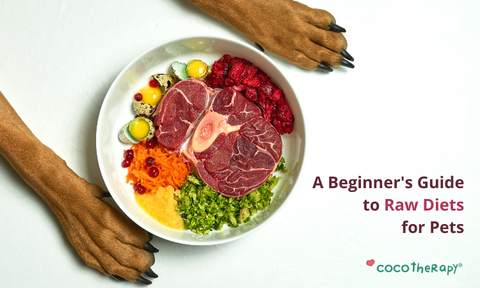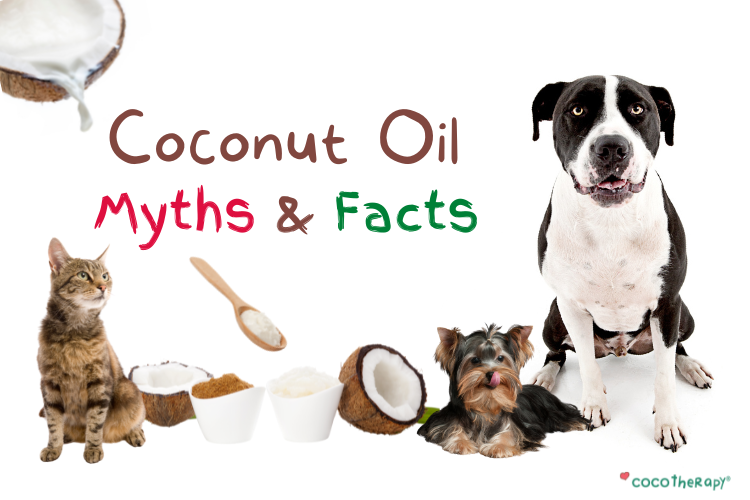August is Rawgust, a month-long celebration of all things raw! Raw diets are becoming more and more popular for pets, but plenty of myths and misconceptions still surround them.
In this post, we'll explore the benefits of a raw food diet and dispel some of the myths around raw feeding. Keep on reading to learn more about raw diets for pets and whether they're right for your furry family member!

What Is a Raw Diet for Pets?
A raw diet for pets is, as the name suggests, a diet that consists primarily of raw, unprocessed foods. This includes meat, organs, bones, vegetables, and fruits. Raw diets are based on the idea that dogs and cats are carnivores and should therefore eat a diet that closely resembles what they would eat in the wild.
Why Feed a Raw Diet?
The benefits of a raw diet are numerous. First and foremost, raw diets are incredibly nutritious. Raw meat is an excellent source of protein, essential amino acids, and omega-fatty acids, all of which are vital for your pet's overall health. Raw foods like fruits and vegetables are also packed full of nutrients, including vitamins, minerals, and antioxidants.
Another benefit of raw diets is that they are highly digestible. This means that your pet will absorb more of the nutrients from their food, leading to better overall health. Raw diets also tend to be less allergenic and easier on the digestive system, which is ideal for pets with sensitivities or allergies.
Other health benefits associated with feeding a raw diet include:
- Improved skin and coat health
- Stronger teeth and bones
- Better weight management
- Reduced risk of chronic diseases
- Immune system support
Raw diets are also beneficial for behavioral reasons. Pets that eat a raw diet tend to be more alert and have more energy. They're also less likely to suffer from anxiety and stress. This is because raw diets provide pets with all the nutrients they need to feel their best – both physically and mentally.
Common Myths & Misconceptions about Raw Feeding
Despite the many benefits of raw diets, there are still plenty of myths and misconceptions about them. Let's explore a few of the most common.
Myth #1: Raw Diets are Unsafe
One of the biggest myths about raw diets is that they're unsafe. Raw meat may contain trace amounts of bacteria; however, dogs and cats’ gut microbiota are uniquely equipped to handle bacteria and microorganisms without a problem.
Furthermore, risk of bacteria for people in the home can be minimized by following safe handling and feeding practices. Raw meat should be kept refrigerated and thawed properly, and hands should be washed thoroughly after handling raw food.
Myth #2: Raw Diets are Expensive
Another common misconception about raw diets is that they're expensive. Raw meat can be pricey, but it's important to remember that you're feeding your pet less of it because it's so nutrient-dense. Plus, the health benefits of a raw diet often outweigh the cost. When you factor in the savings on vet bills, a raw diet can actually be quite economical in the long run.
Myth #3: Raw Diets are Inconvenient
Some people believe that raw diets are too inconvenient to feed on a regular basis. This simply isn't true! These days, there are plenty of commercially prepared raw foods available that make feeding a raw diet easy and convenient. You can even find frozen raw diets that just need to be thawed and served (more on this in a moment).
Should You Feed Your Pet Raw?
Now that we've explored some of the myths and misconceptions about raw diets, let's talk about whether or not you should feed your pet raw. The answer to this question depends on a variety of factors, including your pet's overall health, any existing medical conditions, and your personal preferences.
If you're considering switching your pet to a raw diet, we recommend talking to a holistic veterinarian first. They can help you determine if a raw diet is right for your pet, ensure that you feed a well-balanced raw diet, and give you some tips on how to transition them safely.
There are a few things to keep in mind if you decide to feed your pet raw. First, remember to start slowly and transition your pet gradually. Raw diets are highly nutritious, so it's important not to overdo it at first or you may risk causing digestive upset. Second, make sure you're using high-quality, human-grade ingredients and following safe handling and feeding practices.
You'll also want to make sure that you're feeding your pet a complete and balanced diet. This means preparing or choosing a raw food diet that contains all the nutrients your pet needs to stay healthy. Adding supplements like virgin coconut oil, digestive enzymes, and fish oil can also help to ensure that your pet is getting everything they need.
If you're not sure where to start, there are plenty of commercially prepared raw diets available that make feeding a raw diet easy and convenient. Just be sure to choose a diet that's complete and balanced for your pet's life stage and health needs.
Types of Raw Diets for Pets
So far in this post, we've explained what a raw diet is, the health benefits associated with feeding raw, and some of the myths and misconceptions about raw diets. We've also talked about whether or not you should feed your pet raw, and why it's important to work with your veterinarian if you're considering making the switch.
If you've decided that a raw diet is right for your pet, there are a few different types of raw feeding models to choose from. Two of the most popular and beneficial are the BARF (Biologically Appropriate Raw Food) Model and the Prey Model.
The BARF model includes both muscle meat and bones, as well as organ meat, fruits and vegetables, seeds, and nuts. Proponents of this diet believe that a diverse array of ingredients is necessary to provide pets with all the nutrients they need for optimum health.
The Prey Model, on the other hand, consists primarily of muscle meat, bones, and organ meat. This diet more closely resembles what our pets would eat in the wild and is thought to be more natural and easier to digest.
If you're interested in finding out more about the different raw feeding models, we recommend checking out this excellent primer from Kimberly Gauthier at Keep the Tail Wagging. You'll also find plenty of resources and information about raw diets for pets on her site.
What About Commercial Raw Diets?
As mentioned earlier, commercially prepared raw diets are available that make feeding a raw diet easy and convenient. These diets are often referred to as "complete and balanced" because they're formulated to meet the nutritional needs of pets at different life stages.
Commercial raw diets come in a variety of forms, including frozen, freeze-dried, and dehydrated. One of the benefits of feeding a commercial raw diet is that you can be confident that your pet is getting all the nutrients they need for optimum health. These diets are also typically more affordable than buying all the ingredients to make your own raw food at home.
If you're interested in feeding your pet a commercial raw diet, we recommend talking to your veterinarian or a raw food specialist to find out more. They will be able to recommend a diet that's right for your pet and provide you with all the information you need to get started.
Wrapping Up
We hope this post has been helpful in demystifying raw diets for pets. Rawgust is the perfect time to explore feeding raw, and we hope you'll consider giving it a try. As always, please feel free to reach out to us with any questions or concerns. We're always happy to help!



